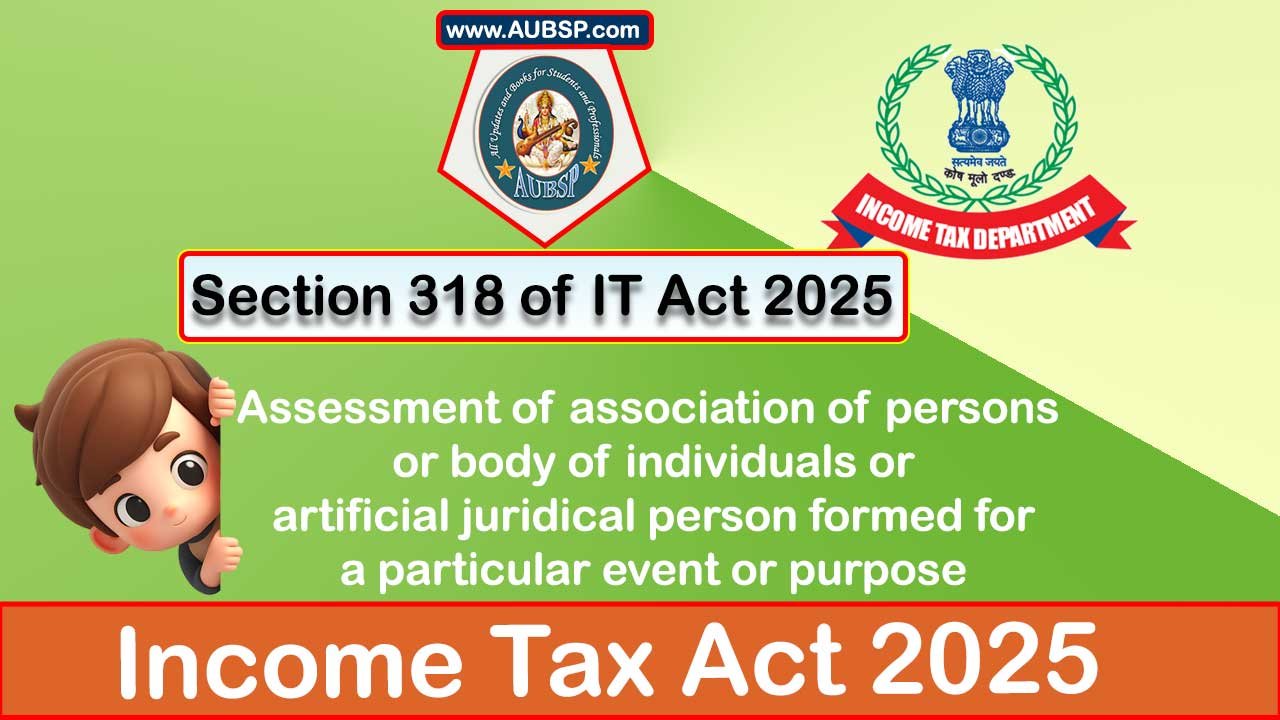Assessment of association of persons or body of individuals or artificial juridical person formed for a particular event or purpose
[Section-318 as per the Income Tax Act, 2025 (this Act) w.e.f. 1st April, 2026.]
Section 318(1) of Income Tax Act 2025
318(1) Irrespective of anything contained in the section 4, where it appears to the Assessing Officer that any association of persons or a body of individuals or an artificial juridical person, formed or established or incorporated for a particular event or purpose in a tax year is likely to be dissolved in the same year or immediately after such year, the total income of such association or body or juridical person for the period beginning from the first day of that tax year up to the date of its dissolution shall be chargeable to tax in that tax year.
Section 318(2) of Income Tax Act 2025
318(2) For the purpose of sub-section (1), the provisions of section 317(2) to (6) shall, so far as may be, apply to any proceedings in the case of any such person as they apply in the case of persons leaving India.
FAQs on Section 318 of Income Tax Act 2025
What is the scope of Section 318(1) of the Income Tax Act, 2025?
Section 318(1) applies to an association of persons (AOP), body of individuals (BOI), or artificial juridical person formed for a specific event or purpose in a tax year and likely to dissolve within or immediately after that year.
What does Section 318(1) override?
It overrides the general provisions of Section 4 of the Act, which governs chargeability of income.
What is the tax implication under Section 318(1)?
If the conditions are met, the total income of such an entity from the beginning of the tax year until the date of dissolution is chargeable to tax in that same tax year.
Who determines if an AOP/BOI or juridical person is likely to dissolve?
The Assessing Officer makes this determination based on facts and circumstances of the case.
What is the relevance of dissolution timing under Section 318(1)?
If the entity is likely to dissolve in the same tax year or immediately thereafter, then its income till the date of dissolution is taxed in that year itself.
How is the tax year determined in this context?
The tax year refers to the financial year starting on April 1st and ending on March 31st.
Does Section 318(1) apply to ongoing or permanent entities?
No, it specifically applies to entities formed for a particular event or purpose that are likely to be dissolved in the same year or immediately after.
What is the purpose of Section 318(2)?
Section 318(2) ensures that the procedural provisions under Section 317(2) to (6) apply similarly to entities covered under Section 318(1).
What do Sections 317(2) to (6) generally deal with?
They deal with the assessment procedures in cases where a person is leaving India, such as advance assessments and immediate tax collection measures.
How do Sections 317(2) to (6) help in the context of Section 318?
They allow the Assessing Officer to apply accelerated assessment and tax collection methods before the entity dissolves.
Can the income of such entities be assessed after dissolution?
No, Section 318 mandates assessment during the same tax year, before or up to the point of dissolution.
Does this provision apply automatically?
No, it applies when the Assessing Officer has reason to believe that the entity is likely to dissolve as per the conditions stated.
Is prior notice required before applying Section 318?
Yes, since assessment proceedings under Section 317(2) to (6) require procedural safeguards, similar safeguards would apply here.
Can the entity contest the determination of likely dissolution?
Yes, the entity can provide evidence or representations during the course of assessment to contest such determination.
Why is Section 318 important for tax administration?
It ensures that temporary entities do not evade taxation by dissolving before their income can be assessed and taxed.
Does this provision apply retrospectively?
No, it is effective from April 1, 2026, and applies prospectively to tax years beginning on or after that date.


